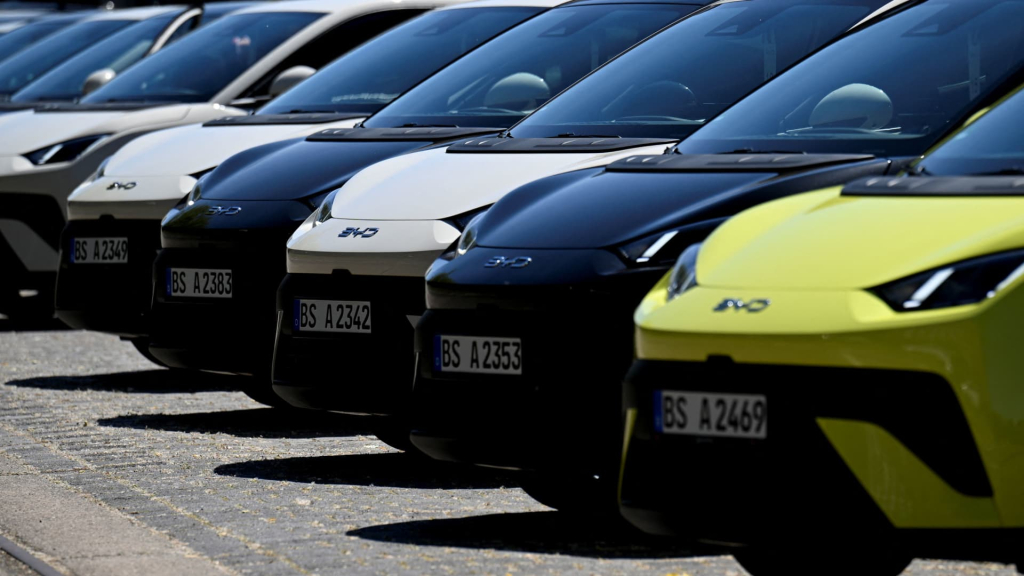Analysts from CLSA, led by Xiao Feng, indicated in a report released on Wednesday that additional price competition is likely in the near future, particularly as BYD is still working to meet its sales targets. Despite their confidence in BYD’s prospects, marked by an outperform rating on the company’s shares listed in Hong Kong, they suggested that Geely is currently the “best positioned” investment option, due to its efficient business structure and competitive vehicle pricing. CLSA has set a price target of 483 Hong Kong dollars (approximately $61.55) for BYD and 23 HKD for Geely, reflecting potential upside of nearly 20% and 28% from the previous Friday’s close.
Geely, a substantial conglomerate, operates electric vehicle brands including Galaxy, Zeekr, and Lynk & Co., which share advanced technology and manufacturing systems. Macquarie analysts highlighted that Geely’s Galaxy NEV division has effectively targeted popular models from BYD, offering enhanced specifications at lower prices. Based on insights gathered from a dealer managing multiple brands in the affluent Suzhou area near Shanghai, the analysts believe Geely’s momentum will continue, particularly as it rolls out new models to compete across BYD’s entire lineup. The Macquarie team has established a price target of 22 HKD for Geely, designating its stock as an outperform.
The analysts also expressed a favorable outlook on Xpeng, a U.S.-listed electric vehicle startup, assigning a price target of $24. They anticipate that Xpeng will gain market share in the near term due to its advanced driver assistance system and forthcoming car models. Xpeng reported over 30,000 vehicle deliveries in May, marking the seventh consecutive month of achieving this milestone, a rare accomplishment amongst its competitors. The company further expanded its offerings with a new model under its more affordable Mona brand.
Other players in the new energy vehicle sector, including Leapmotor and Li Auto, have demonstrated relative stability, with each achieving over 40,000 vehicle deliveries in May. Both companies maintain listings in Hong Kong, and Li Auto also trades on U.S. markets. CLSA analysts recognized Leapmotor’s continuous growth in the mass EV market, attributing its stability to a broad product range and cost-effective models, with a price target of 72 HKD, indicating over 30% potential upside from last Friday’s closing price. Leapmotor did report a net loss in Q1, in contrast to a profit in Q4, while Li Auto managed to maintain profitability during the same quarter, as noted in results released on May 29.
Morgan Stanley analysts remain optimistic, stating that a better-than-expected first quarter should enhance investor confidence in a recovery for the second quarter. They have set a price target of $36 for Li Auto, suggesting more than 20% upside from the closing price on Thursday. They acknowledged Li Auto’s steady recovery trajectory, which they expect to gain further momentum in the latter half of 2025 with new model launches. Notably, Li Auto’s SUVs incorporate gas tanks to extend the electric driving range, pricing them from approximately 244,000 yuan ($34,000). In contrast, BYD offers vehicles starting around 55,800 yuan, with most models priced between 100,000 to 200,000 yuan. The company also has a premium sub-brand, Yangwang, with models exceeding 1 million yuan.
Analysts who remain bullish on BYD also see promise in the company’s international expansion efforts. Nick Lai, head of Asia Pacific auto research at JPMorgan, noted a more positive narrative surrounding BYD among European investors compared to the cautious sentiment in China following the firm’s recent price reductions. After engaging with senior BYD management in London last week, the analysts reaffirmed their long-term optimistic outlook on the automaker, projecting that contributions from overseas markets and BYD’s premium offerings will increasingly impact earnings. They estimate that these segments will together account for over 40% of BYD’s vehicle earnings by 2025, up from 20-25% the previous year, despite representing only about 20% of total volume.
However, the risk of an influx of inexpensive vehicles into markets such as Europe has prompted tariff increases. Additionally, concerns regarding excessive competition are echoed in official commentary within China. Macquarie analysts stated that a resolution to the ongoing price war will depend on economic fundamentals, as production capabilities for both electric and traditional vehicles surpass 50 million units, while annual wholesale volumes hover around 25 million to 27 million. They believe that the market will eventually stabilize through either an uptick in demand or a recalibration of production capacity and industry consolidation, projecting that this may take an additional three to five years. — Finance Newso’s Michael Bloom contributed to this report.


























